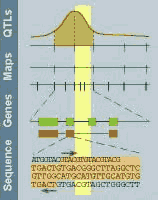
The Animal Quantitative Trait Loci (QTL) Database (Animal QTLdb) strives to collect all publicly available trait mapping data, i.e. QTL (phenotype/expression, eQTL), candidate gene and association data (GWAS), and copy number variations (CNV) mapped to livestock animal genomes, in order to facilitate locating and comparing discoveries within and between species. New data and database tools are continually developed to align various trait mapping data to map-based genome features such as annotated genes.
Many scientific journals require or recommend that any original QTL/association data be deposited into a public database before a paper may be accepted for publication. We provide user/curator accounts for direct data submission, and in return we supply users with a data summary link to facilitate the manuscript review process.
| Database highlights | |
| Publications: | 2,964 |
| Species: | 7 |
| Genome maps: | 22 |
| Measured traits: | 1,584 |
| QTL/associations: | 292,423 |
|
| |
 
This graph is partly adopted from
the RGD with a kind permission | |
Cattle QTLThere are 193,453 currently released QTL data (including eQTL/SNP associations) curated from 1,206 publications. These data are lifted to 5 genome builds. The curated data represent 558 different base traits and 417 trait variants. (see cattle data summary for more details). | |
Chicken QTLThere are 29,116 currently released QTL data (including eQTL/SNP associations) curated from 416 publications. These data are lifted to 4 genome builds. The curated data represent 246 different traits and 246 trait variants. (see chicken data summary for more details). | |
Goat QTLThere are 2713 currently released QTL data (including eQTL/SNP associations) curated from 47 publications. These data are lifted to 2 genome builds. The curated data represent 90 different base traits and 120 trait variants. (see goat data summary for more details). | |
Horse QTLThere are 2,482 currently released QTL data (including eQTL/SNP associations) curated from 129 publications. These data are lifted to 2 genome builds. The curated data represent 71 different base traits and 14 trait variants. (see horse data summary for more details). | |
Pig QTLThere are 57,041 currently released QTL data (including eQTL/SNP associations) curated from 854 publications. These data are lifted to 3 genome builds. The curated data represent 406 different base traits and 1088 trait variants. (see pig data summary for more details). | |
Rainbow Trout QTLThere are 2,201 currently released QTL data (including eQTL/SNP associations) curated from 23 publications. These data are lifted to 2 genome builds. The curated data represent 35 different base traits and 6 trait variants. (see rainbow trout data summary for more details). | |
Sheep QTLThere are 5,417 currently released QTL data (including eQTL/SNP associations) curated from 289 publications. These data are lifted to 4 genome builds. The curated data represent 178 different base traits and 264 trait variants. (see sheep data summary for more details). |
dbxref: Scriptable
access to the Animal QTLdb using a REpresentational State Transfer (REST) protocol, and
dbxref links into the database for extended information.
 Curator / Editor Tools: You can register for a free curator
account to directly get your data into the database. Once your curator's
account is granted, you can find a step-by-step curation guide to help
you proceed, for manual data entry or for batch data upload. You can keep
your data in private status until a time when you wish to make it public.
Curator / Editor Tools: You can register for a free curator
account to directly get your data into the database. Once your curator's
account is granted, you can find a step-by-step curation guide to help
you proceed, for manual data entry or for batch data upload. You can keep
your data in private status until a time when you wish to make it public.
Zhi-Liang Hu, Carissa A. Park, and James M. Reecy (2019). Building a livestock genetic and genomic information knowledgebase through integrative developments of Animal QTLdb and CorrDB. Nucleic Acids Research, Volume 47, Issue D1, 8 January 2019, Pages D701–D710. DOI: 10.1093/nar/gky1084
Zhi-Liang Hu, Carissa A. Park, and James M. Reecy (2018). Development of Animal QTLdb and CorrDB: Resynthesizing Big Data to Improve Meta-analysis of Genetic and Genomic Information. The 11th World Congress on Genetics Applied to Livestock Production (WCGALP). New Zealand, February 11-16, 2018.
Zhi-Liang Hu, Carissa A. Park and James M. Reecy (2016). Developmental progress and current status of the Animal QTLdb. Nucleic Acids Research, 44 (D1): D827-D833. DOI: 10.1093/nar/gkv1233
Zhi-Liang Hu, Carissa A. Park, Xiao-Lin Wu and James M. Reecy (2013). Animal QTLdb: an improved database tool for livestock animal QTL/association data dissemination in the post-genome era. Nucleic Acids Research, 41 (D1): D871-D879; DOI: 10.1093/nar/gks1150
Zhi-Liang Hu, Carissa A. Park, Eric R. Fritz and James M. Reecy (2010). QTLdb: A Comprehensive Database Tool Building Bridges between Genotypes and Phenotypes. Invited Lecture with full paper published electronically on The 9th World Congress on Genetics Applied to Livestock Production (WCGALP). Leipzig, Germany August 1-6, 2010.
Zhi-Liang Hu and James M. Reecy (2007). Animal QTLdb: beyond a repository - A Public Platform for QTL Comparisons and Integration with Diverse Types of Structural Genomic Information. Mammalian Genome, Volume 18(1), 1-4 (2007). DOI: 10.1007/s00335-006-0105-8
Zhi-Liang Hu, Eric Ryan Fritz and James M. Reecy (2007). AnimalQTLdb: a livestock QTL database tool set for positional QTL information mining and beyond. Nucleic Acids Research, 2007, 35 (Database issue):D604-D609.